#call center calling software
Explore tagged Tumblr posts
Text
#leadsrain#ringless voicemail#call center software#call center#marketing#contact center#RVM#voicemail
2 notes
·
View notes
Text
How cloud contact centers improve corporate work performance
In today's dynamic business landscape, cloud contact centers have emerged as a powerful tool for enhancing corporate work performance. By leveraging the cloud's scalable infrastructure and advanced capabilities, these solutions empower businesses to streamline operations, optimize customer interactions, and achieve their strategic goals.
Cloud Contact Center Software Solutions in India | Dialer Service Provider
Key benefits of cloud contact centers include:
Enhanced Customer Experience: Cloud contact centers enable businesses to provide omnichannel support, seamlessly integrating voice, chat, email, and social media interactions. This unified approach ensures that customers receive timely and consistent support across all channels, fostering satisfaction and loyalty.
Improved Agent Productivity: Cloud-based solutions provide agents with access to real-time information, knowledge bases, and AI-powered tools, enabling them to resolve issues more efficiently and effectively. This streamlined workflow boosts agent productivity and reduces handling times.
Scalability and Flexibility: Cloud contact centers can seamlessly scale up or down to meet fluctuating demand, ensuring that businesses have the resources they need to handle spikes in customer interactions without incurring upfront hardware costs.
Cost-effectiveness: Cloud-based solutions eliminate the need for expensive on-premises infrastructure and maintenance while offering predictable subscription-based pricing models. This translates into significant cost savings for businesses of all sizes.
Advanced Analytics and Insights: Cloud contact centers provide valuable data insights into customer interactions, enabling businesses to identify trends, improve processes, and make data-driven decisions that enhance customer experience and operational efficiency.
Business Continuity and Resilience: Cloud contact centers offer disaster recovery capabilities, ensuring that businesses can maintain operations even in the event of unforeseen disruptions. This resilience is crucial for safeguarding customer satisfaction and protecting revenue streams.
By embracing cloud contact centers, businesses can gain a competitive edge, optimize their workforce, and deliver exceptional customer experiences that drive growth and success.
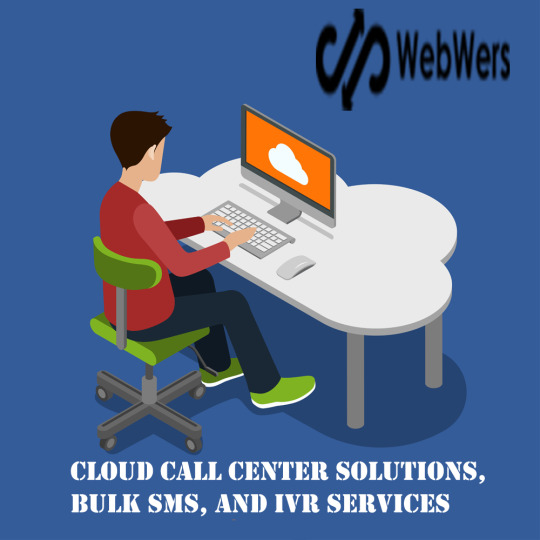
Source: https://webwerscloudtech.blogspot.com/2023/11/how-cloud-contact-centers-improve.html
#cloud contact centers#cloud call center solutions#Cloud Contact Center Software Solutions in India#Webwers
3 notes
·
View notes
Text

What is an Omnichannel Contact Center?
An omnichannel contact center solution uses cloud-based software to manage customer interactions across many channels on one platform.
#omnichannel contact center software#omnichannel call center#omnichannel contact center solutions#omnichannel contact center
0 notes
Text
How to Handle Inbound Calls: A Complete Guide for Call Center Success
Inbound calls are calls made by customers to a company, usually for support, inquiries, order tracking, or service-related issues. Unlike outbound calls (which are initiated by agents), inbound calls are reactive in nature and require agents to be well-prepared, responsive, and empathetic.
Steps to Handle Inbound Calls Effectively
1. Answer Promptly and Politely
First impressions matter. Always aim to answer calls within 2-3 rings. Start with a warm greeting that includes:
The company name
Your name
An offer to help
Example: “Good morning! Thank you for calling [Company Name], this is Sarah speaking. How may I assist you today?”
2. Practice Active Listening
Give the caller your full attention. Avoid interrupting, and show that you’re listening by using verbal nods like “I see” or “Got it.” Use their name if possible to personalize the interaction.
3. Clarify and Confirm
Repeat or paraphrase what the caller said to confirm your understanding. This avoids miscommunication and shows professionalism.
Example: “So just to confirm, you're having trouble logging into your account, correct?”
4. Stay Calm and Professional—Even with Difficult Callers
Not all calls are pleasant. Some customers may be upset or angry. Remain calm, don’t take it personally, and use empathy-driven phrases like:
“I understand how frustrating that must be.”
“Let me see what I can do to fix this for you right away.”
5. Provide Clear, Concise Solutions
Once you understand the problem, provide a solution in clear steps. Avoid jargon and ensure the customer knows what to expect next. If a resolution will take time, explain the process and timeline.
6. Use Call Handling Tools and CRM Software
Modern call centers use tools like:
Customer Relationship Management (CRM) systems to view customer history
Knowledge bases to quickly find information
AI-powered assistants to suggest answers and automate workflows
These tools improve response time and help deliver a consistent customer experience.
7. Summarize the Call Before Ending
Before ending the call, summarize what was discussed and confirm that the issue was resolved. Ask if there’s anything else you can assist with.
Example: “Just to recap, we’ve reset your password and you should now be able to log in. Is there anything else I can help you with today?”
8. End with Courtesy
Close the call with a friendly tone. Example: “Thank you for calling [Company Name], and have a great day!”
Best Practices for Inbound Call Handling
Train agents regularly on product updates, customer service skills, and using support tools.
Use call scripts as a guide—but allow flexibility to sound natural.
Monitor KPIs like Average Handling Time (AHT), First Call Resolution (FCR), and Customer Satisfaction (CSAT).
Record and review calls for quality assurance and coaching purposes.
Invest in automation for routing calls to the right departments or agents faster.
The Role of Automation in Inbound Call Handling
While human empathy is irreplaceable, call center automation tools like IVR (Interactive Voice Response), AI chatbots, and automatic ticketing can handle repetitive inquiries, reduce wait times, and improve efficiency. In 2025, automation is essential for delivering fast, consistent support—while freeing up agents for more complex calls.
Conclusion
Handling inbound calls isn’t just about answering the phone—it’s about delivering a positive customer experience that builds trust and loyalty. By combining professional communication, empathy, and the right tools, such as inbound call center software, businesses can handle inbound calls efficiently and effectively.
Train your agents well, empower them with technology, and always keep the customer at the center of every interaction. That’s the key to inbound call success in today’s customer-driven world.
1 note
·
View note
Text
What Is Accent Harmonizer Software and How It Transforms Call Centers
In today's globalized world, businesses increasingly rely on international contact centers to provide customer support and services. However, a significant challenge often arises from the diverse range of accents spoken by agents, which can lead to communication barriers and negatively impact customer experience. This is where accent harmonizer software steps in, offering a powerful solution to bridge these communication gaps and revolutionize the way call centers operate.

Understanding the Core: What is Accent Harmonizer Software?
Accent harmonizer software, also known as AI accent voice clarity solutions, leverages cutting-edge artificial intelligence and natural language processing (NLP) to subtly modify and standardize accents in real-time. It doesn't eliminate accents entirely, but rather refines them to improve intelligibility and ensure clear communication between agents and customers from diverse linguistic backgrounds. Think of it as a sophisticated audio filter, enhancing the clarity and understanding of speech without stripping away the agent's unique identity.
The Need for Accent Neutralization for Contact Centers
The benefits of implementing accent neutralization for contact centers are multifaceted and far-reaching. Here are some key driving factors:
Improved Customer Comprehension: Accent harmonization directly addresses the issue of communication barriers caused by unfamiliar accents. By enhancing speech clarity for contact centers, customers can more easily understand agents, leading to smoother interactions and faster resolution of issues.
Enhanced Customer Satisfaction: When customers understand and feel understood, their satisfaction levels naturally increase. Reduced frustration and improved efficiency contribute to a more positive customer experience, fostering loyalty and positive brand perception.
Reduced Call Handling Time: Misunderstandings due to accent differences often lead to longer call handling times as agents and customers struggle to comprehend each other. Accent harmonization streamlines communication, reducing the need for repetition and clarification, ultimately lowering average call handling time.
Empowered Agents: Agents, particularly those with strong regional accents, can sometimes feel self-conscious or experience negative feedback due to communication difficulties. Accent harmonization can empower agents by boosting their confidence and allowing them to focus on providing excellent service without the worry of being misunderstood.
Global Reach and Scalability: As businesses expand into new markets, the need for multilingual and multi-accent support grows. Accent harmonizer software allows contact centers to efficiently manage diverse linguistic landscapes, ensuring consistent and high-quality service across different regions.
Data-Driven Insights: Many accent harmonization solutions offer valuable data analytics, providing insights into common accent-related challenges and areas for improvement. This data can be used to optimize agent training, refine software settings, and further enhance communication effectiveness.
How Accent Harmonizer Software Works
The technology behind accent harmonization is complex, but the underlying principles are relatively straightforward:
Audio Capture: The software captures the agent's voice input in real-time.
Accent Analysis: AI algorithms analyze the captured audio, identifying the specific accent and its characteristics.
Accent Modification: The software subtly adjusts the pronunciation and intonation of the agent's speech, making it more neutral and universally understandable.
Real-time Output: The modified audio is transmitted to the customer without any noticeable delay.
Modern solutions utilize advanced deep learning models trained on vast datasets of diverse accents. This allows them to accurately identify and modify accents with minimal distortion or robotic effects, maintaining the naturalness of the agent's voice.
Beyond Neutralization: Enhancing Overall Communication
While the primary focus is on accent modification, some accent harmonizer software solutions offer additional features that further enhance communication:
Noise Cancellation: Eliminating background noise ensures that the agent's voice is clear and audible.
Voice Enhancement: Optimizing voice quality for improved clarity and intelligibility.
Real-time Translation: Integrating with translation services to provide on-the-fly translation for multilingual interactions.
Conclusion: The Future of Accent Harmonization in Contact Centers
Accent harmonizer software is rapidly transforming the landscape of contact centers, offering a powerful solution to overcome communication challenges and enhance customer experience. By leveraging the power of AI and NLP, these solutions are breaking down linguistic barriers, empowering agents, and enabling businesses to deliver consistent, high-quality service to a global audience. As technology continues to evolve, accent harmonization will undoubtedly play an increasingly vital role in shaping the future of customer communication within contact centers and beyond, making speech clarity for contact centers a key performance indicator.
#accent neutralization for contact centers#ai accent voice clarity#speech clarity for contact centers#accent harmonizer software#ai#call center auditing#voice chatbots
1 note
·
View note
Text

Hi !... Hello amazing clients.. Get the best communication solutions for your business! We offer a wide range of services to help you stay connected with your customers and team. We Offer Global DID Numbers Call center setup Phone system configuration setup Tollfree number SIP Trunking Auto Dialer Inbound/Outbound Calls IVR SYSTEM setup Trusted by Industry Telnyx | Vonage | Twilio | Plivo | DIDWW | Agora | 3cx and more Contact us today
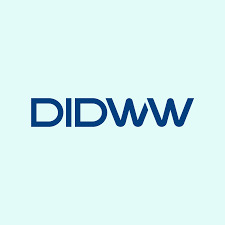
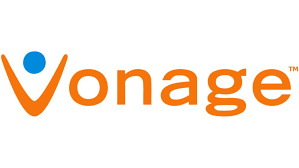


Hi !... Hello amazing clients.. Get the best communication solutions for your business! We offer a wide range of services to help you stay connected with your customers and team. We Offer Global DID Numbers Call center setup Phone system configuration setup Tollfree number SIP Trunking Auto Dialer Inbound/Outbound Calls IVR SYSTEM setup Trusted by Industry Telnyx | Vonage | Twilio | Plivo | DIDWW | Agora | 3cx and more Contact us today
#911 abc#andor#animation#arcane#art#artists on tumblr#artwork#cats of tumblr#conclave#cookie run kingdom#3cx#call center#voip providers#voip#voipsolutions#voip services#voip phone system#software#telecom
1 note
·
View note
Text
Why Modern Businesses Can’t Live Without Call Center Software
Every day, millions of customers call businesses seeking help, answers, or reassurance. Yet behind every seamless conversation is an often-overlooked hero: call center software. If you’ve ever dialed into a customer support line and experienced quick routing, helpful agents, or a perfect callback, chances are you’ve benefited from this powerful technology.
But “call center software” can feel like a dry, technical term—something relegated to IT departments and CIOs. The reality? It’s a living, breathing ecosystem that shapes how we connect, empathize, and solve problems in a digital age. Let’s dive into a human-centric view of why modern businesses need robust call center software, how it has evolved, and where it’s heading.
Beyond Dialing: The Human Connection at the Core
Imagine you’re a new parent anxious about your baby’s first cold. You pick up the phone, dial the pediatric hotline, and within seconds, you’re speaking with a compassionate voice who understands. That agent didn’t just press random buttons. They likely relied on call center software that instantly pulled up your account, past inquiries, and the hospital’s triage guidelines—allowing them to answer your concerns with speed and empathy.
That’s the beauty of modern systems: they enable real-time context. When agents see historical data—past support tickets, billing details, or even a customer’s emotional sentiment analysis—they can tailor their response. This isn’t just efficiency. It’s human connection, fueled by technology.
How Did We Get Here? A Brief History of Call Technology
Quick refresher for context: once upon a time, call centers were literally rows of phones, sticky notes, and manual logs. Agents shuffled paper forms and scribbled customer details on yellow pads. Metrics were tallied by hand. The process was slow, error-prone, and impersonal. Today, that concept seems archaic.
The first generation of call center software emerged in the 1980s with rudimentary Automatic Call Distributors (ACD). These systems would simply route incoming calls to the next available agent. In the 1990s, computerized Customer Relationship Management (CRM) tools allowed agents to see customers’ past interactions. Fast-forward to the 2010s—and we have cloud-based, AI-augmented platforms that handle omnichannel support (voice, email, chat, SMS, social media) all in one dashboard. It’s been an evolution of integration, automation, and intelligence.
What Makes Modern Call Center Software Different?
Let’s break down the key pillars that distinguish today’s platforms:
Omnichannel Integration Customers expect to reach out on their terms—whether that’s a phone call, text message, social post, or video chat. A best-in-class call center software consolidates these channels into a single interface. Agents don’t need ten different windows open; they simply click through a unified view of each customer’s journey.
Real-Time Analytics and Reporting In the past, quality assurance meant managers randomly listening to recorded calls. Now, intelligent systems analyze every interaction for sentiment trends, call resolution times, and agent performance. Dashboards update in real time, enabling supervisors to spot bottlenecks—like high call abandonment in certain hours—and make immediate adjustments.
AI-Powered Assistance Speech recognition, natural language processing, and automated chatbots handle routine queries—freeing agents to tackle the complex, emotionally nuanced issues. For instance, if you’re calling your bank to dispute a fraudulent charge, a chatbot can verify your identity and gather preliminary facts, then escalate you to a live agent who already knows the details. That synergy between human and machine is the hallmark of contemporary call center solutions.
Cloud Flexibility Gone are the days of massive on-premise hardware racks. Cloud-based call center software is scalable, cost-effective, and accessible from anywhere with an internet connection. In a post-pandemic world, remote agents can log in from home, coffee shops, or co-working spaces, without missing a beat.
Real-World Impact: Stories Behind the Screens
Take a regional healthcare provider that implemented a modern call center software platform last year. Before the upgrade, patients faced 20-minute hold times and repeated paperwork—often needing to re-explain symptoms to multiple agents. The new system changed the game. Patient data was instantly available, calls were prioritized by urgency, and clinicians could schedule follow-ups directly within the platform. As a result, patient satisfaction scores rose by 35%, and hospital readmission rates dropped by 12%. That’s the kind of direct, measurable impact today’s call center solutions can deliver.
Or consider a fast-growing e-commerce brand. Peak season used to be a nightmare—call volumes spiked, hold times soared, and carts were abandoned. After migrating to a cloud-based call center software, they introduced automated callbacks, AI-driven self-service menus, and predictive staffing tools. Holiday stress? Reduced by 60%. Customer retention? Climbing steadily.
Choosing the Right Call Center Software Partner
With so many options available, how do you pick the ideal solution? Here are some guiding questions:
Scalability: Will the platform grow with your business? Can you add new agents, languages, or regions without ripping and replacing?
Integration: Does it seamlessly connect with your existing CRM, ticketing, and knowledge-base tools? Or will you spend months merging data silos?
Omnichannel Support: Are voice, email, chat, and social channels natively supported—without costly add-ons?
Customization: Can you tailor IVR scripts, agent scripts, and automated workflows to reflect your unique brand voice?
Security and Compliance: Does it meet industry standards—HIPAA in healthcare, PCI DSS in finance, GDPR in Europe?
Remember, selecting a vendor isn’t just a software purchase. It’s a partnership. The right call center software provider becomes an extension of your team—offering strategic guidance, training, and optimization best practices.
The Human Element: Agents Are at the Heart
In all the talk about technology, it’s easy to forget one simple truth: customers still crave genuine human interaction. A well-designed call center software platform doesn’t replace agents; it empowers them.
When agents have a single view of customer history, real-time guidance on next best actions, and AI-suggested knowledge snippets, they aren’t scrambling for answers. They can focus on listening, empathizing, and problem-solving. Imagine being on the other end of the line. Hearing a calm, informed voice who already understands your issue—that’s the difference between frustration and loyalty.
In fact, many top-tier platforms offer built-in coaching modules. Supervisors can whisper best-practice prompts to new agents during live calls, ensuring consistent service quality and faster onboarding. That level of support doesn’t just boost customer satisfaction—it builds agent confidence and reduces burnout.
The Future: AI, Automation, and Beyond
What’s next for call center software? Brace yourself—hybrid human-AI teams are just the beginning.
Emotion AI: Systems that gauge caller mood through tone analysis. If a customer sounds frustrated, the call is escalated to a specialized “tact team” trained in de-escalation.
Predictive Analytics: Not only analyzing historical call data but forecasting spikes in inquiries—for example, identifying a potential product defect trend before it goes viral on social media.
Voice Biometrics: Secure, frictionless authentication that identifies callers by voiceprint, drastically reducing “forgot my password” hang-ups.
Augmented Reality (AR) Integration: Remote troubleshooting where an agent guides customers through visual overlays on their smartphone camera—imagine replacing a filter in a home appliance while the agent sees exactly what you see.
These innovations won’t replace human agents—they’ll make them invaluable by offloading mundane work and augmenting their skills. That’s the promise of the next wave of call center software: true human-AI collaboration.
Final Thoughts: Embrace the Evolution
The journey from manual switchboards to AI-powered, cloud-based omnichannel hubs has been nothing short of extraordinary. And while the phrase “call center software” might sound utilitarian, in practice, it’s the engine of empathy, efficiency, and excellence in customer experience.
Whether you’re a small business trying to stand out, a healthcare provider aiming to reduce patient anxiety, or an enterprise looking to optimize global support operations, investing in the right call center software isn’t optional—it’s a strategic imperative.
So next time you find yourself on hold—or, better yet, speaking with a knowledgeable agent—remember there’s a symphony of technology behind that moment, allowing genuine human connection to shine through. Because at the end of the day, it’s not just about routing calls; it’s about building trust.
0 notes
Text
0 notes
Text
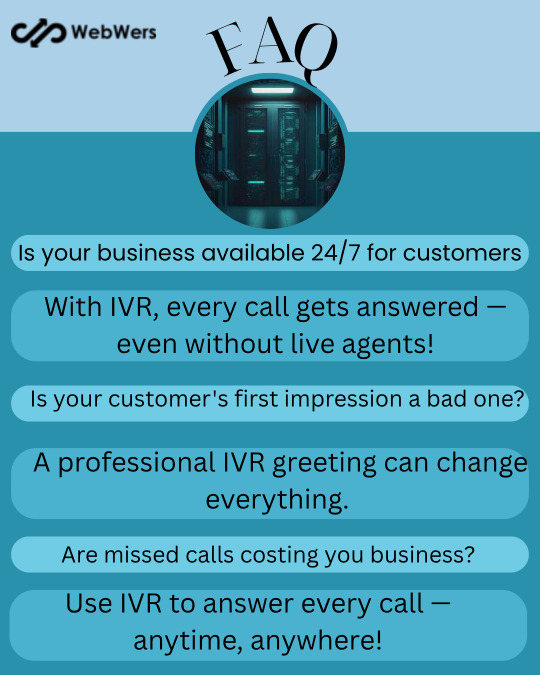
📞 Answer Every Call, Anytime — Thanks to IVR!
Missed calls = missed opportunities. With WebWers' intelligent IVR solutions, your business stays connected 24/7 — no live agent required! Whether it's making a strong first impression or ensuring every customer gets a response, IVR transforms the way you handle communication.
Stay professional. Stay available. Stay ahead.
#cloud call center solutions#dialer service provider#auto dialer service providers in delhi ncr#technology#auto dialer software#webwers#ivr solutions
0 notes
Text
Looking for Smart Call Center Software in Kuwait? Centrix Plus Has You Covered!

Let’s face it—customers today expect fast, friendly, and seamless support, no matter where they are or what channel they use to reach you. And if you're still using old-school, on-premise systems to run your call center, you're probably feeling the pressure.
That’s where Centrix Plus, Kuwait’s very own tech partner, comes in. Our cloud-based call center and contact software is designed to help you connect with customers effortlessly—whether it’s over a call, live chat, email, or social media.
So, Why Go Cloud-Based?
Great question. Going cloud-based means:
No bulky hardware. Everything runs online.
Add agents on the fly. Need to grow your team? It takes minutes.
Work from anywhere. Your agents just need internet access.
Stay in the know. Real-time dashboards show you exactly what’s happening.
With Centrix Plus, you’re not just getting software—you’re getting a complete solution built for Kuwait’s businesses.
What Makes Centrix Plus Different?
We’re not some overseas brand trying to fit into the Kuwaiti market. We are part of the Kuwaiti market. We understand your customers, your language (literally), and your challenges. That’s why our Kuwait cloud-based call center & contact software comes packed with local-ready features like:
Smart IVR and call routing
Real-time call monitoring and coaching
CRM integrations (Zoho, HubSpot, Salesforce—you name it)
Arabic and English language support
AI-powered chat and ticketing
Fully compliant with Kuwait’s data regulations
Who’s It For?
If you’re in:
Banking
Healthcare
Retail
Delivery & Logistics
Or even Government Services...
...then yes, this solution is built for you. Whether you're running a small contact center or managing a large support team, Centrix Plus scales with your business.
What Our Clients Are Saying
Our clients tell us they’ve:
Cut down on call wait times
Boosted customer satisfaction
Saved money on setup and maintenance
Made their agents way more productive
And the best part? They didn’t need weeks or months to get started. Just a few days, and they were up and running.
Ready to Make the Switch?
Your customers deserve better. Your team deserves tools that work smarter. And your business deserves a local partner that gets it.
Let’s talk. Book your free consultation with Centrix Plus now and see how we can help transform your customer support—one call at a time.
0 notes
Text

Call Center Solutions Dubai
Upgrade your communication with our IP telephony solutions. Explore call center software, IVR systems, and VoIP business telephone systems for smarter, efficient calls.
#ip telephony solutions#ip telephony service#call center solutions#call center software#voip business telephone system#Interactive Voice Response ivr#intelligent call routing system#IP telephony systems#IVR Solutions#cisco ip phone system#grandstream phone system
0 notes
Text
Integrating AI Call Transcription into Your VoIP or CRM System
In today’s hyper-connected business environment, customer communication is one of the most valuable assets a company possesses. Every sales call, support ticket, or service request contains rich data that can improve business processes—if captured and analyzed properly. This is where AI call transcription becomes a game changer. By converting voice conversations into searchable, structured text, businesses can unlock powerful insights. The real value, however, comes when these capabilities are integrated directly into VoIP and CRM systems, streamlining operations and enhancing customer experiences.
Why AI Call Transcription Matters
AI call transcription leverages advanced technologies such as Automatic Speech Recognition (ASR) and Natural Language Processing (NLP) to convert real-time or recorded voice conversations into text. These transcripts can then be used for:
Compliance and auditing
Agent performance evaluation
Customer sentiment analysis
CRM data enrichment
Automated note-taking
Keyword tracking and lead scoring
Traditionally, analyzing calls was a manual and time-consuming task. AI makes this process scalable and real-time.
Key Components of AI Call Transcription Systems
Before diving into integration, it’s essential to understand the key components of an AI transcription pipeline:
Speech-to-Text Engine (ASR): Converts audio to raw text.
Speaker Diarization: Identifies and separates different speakers.
Timestamping: Tags text with time information for playback syncing.
Language Modeling: Uses NLP to enhance context, punctuation, and accuracy.
Post-processing Modules: Cleans up the transcript for readability.
APIs/SDKs: Interface for integration with external systems like CRMs or VoIP platforms.
Common Use Cases for VoIP + CRM + AI Transcription
The integration of AI transcription with VoIP and CRM platforms opens up a wide range of operational enhancements:
Sales teams: Automatically log conversations, extract deal-related data, and trigger follow-up tasks.
Customer support: Analyze tone, keywords, and escalation patterns for better agent training.
Compliance teams: Use searchable transcripts to verify adherence to legal and regulatory requirements.
Marketing teams: Mine conversation data for campaign insights, objections, and buying signals.
Step-by-Step: Integrating AI Call Transcription into VoIP Systems
Step 1: Capture the Audio Stream
Most modern VoIP systems like Twilio, RingCentral, Zoom Phone, or Aircall provide APIs or webhooks that allow you to:
Record calls in real time
Access audio streams post-call
Configure cloud storage for call files (MP3, WAV)
Ensure that you're adhering to legal and privacy regulations such as GDPR or HIPAA when capturing and storing call data.
Step 2: Choose an AI Transcription Provider
Several commercial and open-source options exist, including:
Google Speech-to-Text
AWS Transcribe
Microsoft Azure Speech
AssemblyAI
Deepgram
Whisper by OpenAI (open-source)
When selecting a provider, evaluate:
Language support
Real-time vs. batch processing capabilities
Accuracy in noisy environments
Speaker diarization support
API response latency
Security/compliance features
Step 3: Transcribe the Audio
Using the API of your chosen ASR provider, submit the call recording. Many platforms allow streaming input for real-time use cases, or you can upload an audio file for asynchronous transcription.
Here’s a basic flow using an API:
python
CopyEdit
import requests
response = requests.post(
"https://api.transcriptionprovider.com/v1/transcribe",
headers={"Authorization": "Bearer YOUR_API_KEY"},
json={"audio_url": "https://storage.yourvoip.com/call123.wav"}
)
transcript = response.json()
The returned transcript typically includes speaker turns, timestamps, and a confidence score.
Step-by-Step: Integrating Transcription with CRM Systems
Once you’ve obtained the transcription, you can inject it into your CRM platform (e.g., Salesforce, HubSpot, Zoho, GoHighLevel) using their APIs.
Step 4: Map Transcripts to CRM Records
You’ll need to determine where and how transcripts should appear in your CRM:
Contact record timeline
Activity or task notes
Custom transcription field
Opportunity or deal notes
For example, in HubSpot:
python
CopyEdit
requests.post(
"https://api.hubapi.com/engagements/v1/engagements",
headers={"Authorization": "Bearer YOUR_HUBSPOT_TOKEN"},
json={
"engagement": {"active": True, "type": "NOTE"},
"associations": {"contactIds": [contact_id]},
"metadata": {"body": transcript_text}
}
)
Step 5: Automate Trigger-Based Actions
You can automate workflows based on keywords or intent in the transcript, such as:
Create follow-up tasks if "schedule demo" is mentioned
Alert a manager if "cancel account" is detected
Move deal stage if certain intent phrases are spoken
This is where NLP tagging or intent classification models can add value.
Advanced Features and Enhancements
1. Sentiment Analysis
Apply sentiment models to gauge caller mood and flag negative experiences for review.
2. Custom Vocabulary
Teach the transcription engine brand-specific terms, product names, or industry jargon for better accuracy.
3. Voice Biometrics
Authenticate speakers based on voiceprints for added security.
4. Real-Time Transcription
Show live captions during calls or video meetings for accessibility and note-taking.
Challenges to Consider
Privacy & Consent: Ensure callers are aware that calls are recorded and transcribed.
Data Storage: Securely store transcripts, especially when handling sensitive data.
Accuracy Limitations: Background noise, accents, or low-quality audio can degrade results.
System Compatibility: Some CRMs may require custom middleware or third-party plugins for integration.
Tools That Make It Easy
Zapier/Integromat: For non-developers to connect transcription services with CRMs.
Webhooks: Trigger events based on call status or new transcriptions.
CRM Plugins: Some platforms offer native transcription integrations.
Final Thoughts
Integrating AI call transcription into your VoIP and CRM systems can significantly boost your team’s productivity, improve customer relationships, and offer new layers of business intelligence. As the technology matures and becomes more accessible, now is the right time to embrace it.
With the right strategy and tools in place, what used to be fleeting conversations can now become a core part of your data-driven decision-making process.

#AI call transcription#VoIP integration#CRM integration#Speech-to-text software#Call transcription software#Real-time transcription#VoIP call recording#CRM automation#Customer call insights#Voice analytics#AI transcription for sales calls#Transcription in customer support#CRM call log automation#Automatic call summary#AI speech recognition tools#Sales call transcript analysis#Customer service call transcription#AI voice to text CRM#Call center compliance tools#Conversation intelligence software
0 notes
Text

Hi !... Hello amazing clients.. Get the best communication solutions for your business! We offer a wide range of services to help you stay connected with your customers and team. We Offer Global DID Numbers Call center setup Phone system configuration setup Tollfree number SIP Trunking Auto Dialer Inbound/Outbound Calls IVR SYSTEM setup Trusted by Industry Telnyx | Vonage | Twilio | Plivo | DIDWW | Agora | 3cx and more Contact us today
#911 abc#andor#animation#arcane#art#artists on tumblr#artwork#cats of tumblr#conclave#cookie run kingdom#3cx#call center#voip phone system#voip#voipsolutions#voip providers#voip services#software#telecom
0 notes
Text
A Day Without Team Assist
Team Assist is a comprehensive productivity and management solution designed to optimize remote and on-site workflows. It helps boost efficiency, accountability, and performance across your team.
Imagine managing your team without Team Assist:
📧 Endless emails asking for attendance updates, 🔍 Guessing who’s productive and who’s not, 📝 Manually checking timesheets, one by one, ⏱ Tracking active vs inactive hours—pure guesswork, 💼 Chasing employees for screenshots to verify work, 🚫 No real-time insights—just assumptions and confusion.
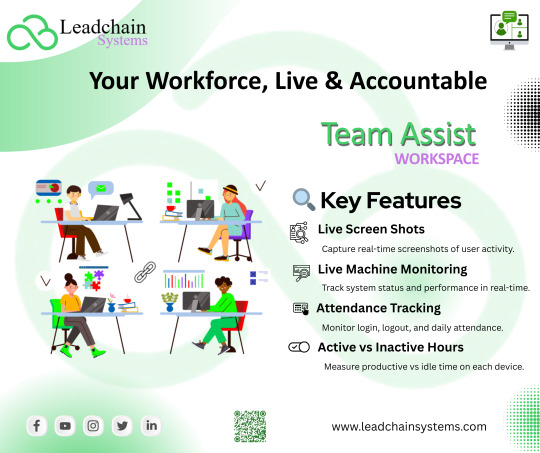
Now, imagine Team Assist handling all of that for you: ✅ Automated Attendance Tracking—no more follow-ups, 📊 Live Employee Monitoring—real-time productivity insights, ⏱ Accurate Timesheets—generated automatically, 📈 Active vs Inactive Hours—clear trends, no guesswork, 📸 Live Screenshots—instant snapshots of work, 🔍 Comprehensive Reports—everything you need at a glance.
💡 The difference is clear. With Team Assist, you focus on what matters—growth, not guesswork.
Explore More: https://www.leadchainsystems.com/leadchain-teamassist/
#business#webdevelopment#artificial intelligence#marketing#software engineering#digital art#leadchainsystems#programming#businessautomation#whatsappbusiness#adaywithoutteamassist#team#IT Services & Software Companies#BPOs & Call Centers#Digital Marketing Agencies#E-commerce Operations Teams#Accounting & Finance Firms#Remote Startups#Customer Support Teams#HR & Staffing Companies#Freelance Team Networks#Educational Institutions
0 notes
Text
Boost Business Communication 4X with MCUBE’s Smart Cloud Contact Center
See how MCUBE powers smart conversations to multiply your business communication efficiency by 4X. Experience seamless customer engagement and easy scaling with cloud contact center solutions designed for modern businesses.
#cloud contact center#business communication#cloud telephony#MCUBE contact center#smart call management#IVR solution#call routing#remote support system#cloud-based customer service#scalable contact center#contact center software India#call center automation#virtual call center#customer engagement#inbound and outbound calling solution
0 notes
Text
0 notes